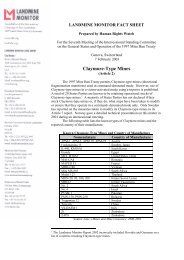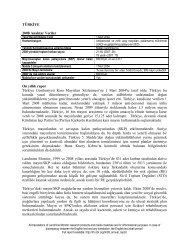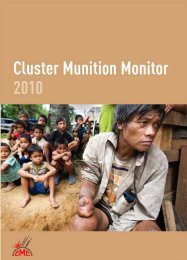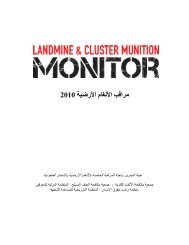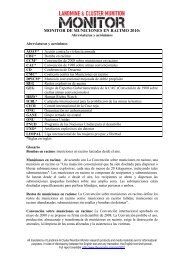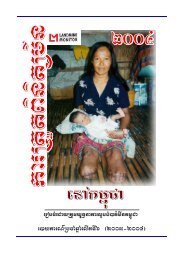Download PDF - Landmine and Cluster Munition Monitor
Download PDF - Landmine and Cluster Munition Monitor
Download PDF - Landmine and Cluster Munition Monitor
Create successful ePaper yourself
Turn your PDF publications into a flip-book with our unique Google optimized e-Paper software.
<strong>Cluster</strong> <strong>Munition</strong> <strong>Monitor</strong> 2012<br />
The CMC paper recommends that a desk assessment of available information first be conducted to establish an initial<br />
underst<strong>and</strong>ing of the contamination problem. Then non-technical survey (NTS) 66 should be used to better identify the<br />
“strike footprint” by gathering information in the field through interviews with the local population, military personnel,<br />
<strong>and</strong> other relevant stakeholders. Information garnered from the desk assessment (on weapon delivery systems, ground<br />
conditions, battlefield data, etc.) is compared with evidence collected in the field <strong>and</strong> duplicate or otherwise invalid<br />
initially suspected area records can be cancelled at this point. Technical survey (TS) 67 more accurately determines the<br />
“strike footprint” which is identified by verification of the exact location of the footprint including boundaries of the<br />
cluster munition strike.<br />
In addition, the CMC paper notes that clearance of cluster munition remnants is not mine clearance <strong>and</strong> should<br />
not be regarded as such. The CMC has suggested that states use the basic principles laid out in IMAS 09.11 (Battle<br />
Area Clearance) to ensure that clearance is done cost-effectively <strong>and</strong> without excessive layers of measures that limit<br />
efficiency without increasing safety. When seeking to release l<strong>and</strong>, however, care must be taken to ensure that certain<br />
basic principles are followed. In particular, all areas confirmed to be contaminated with cluster munition remnants must<br />
be completely cleared, as required by the convention. In addition, the process of releasing l<strong>and</strong> through NTS <strong>and</strong> TS must<br />
be accountable <strong>and</strong> follow applicable st<strong>and</strong>ards <strong>and</strong> country-specific st<strong>and</strong>ing operating procedures (SOPs).<br />
At the Second Meeting of States Parties to the Convention on <strong>Cluster</strong> <strong>Munition</strong>s in September 2011, States Parties<br />
agreed to encourage the implementation of recommendations submitted by Australia on the use of all appropriate methods<br />
to release l<strong>and</strong> that is deemed not to be contaminated. 68<br />
Clearance by States Parties<br />
• In Afghanistan, the Mine Action Coordination Center for Afghanistan did not report any clearance of unexploded<br />
submunitions in 2011. 69 However, the RONCO security firm reported discovering 200 ab<strong>and</strong>oned<br />
“barrels” of cluster munitions, each containing 24 submunitions, at Kabul International airport. 70<br />
• In Bosnia <strong>and</strong> Herzegovina (BiH) no cluster munition clearance task was undertaken in 2011. 71 In the course<br />
of demining operations three organizations—FBIH Civil Protection, N&N IVSA, <strong>and</strong> UXB Balkans—cleared<br />
59 submunitions from areas totaling 85,256m2. 72 In April 2012, BiH stated that of the 12.3km2 of area suspected<br />
to be contaminated by cluster munitions, the “real area for clearance will be about 4km2, while the rest<br />
of the area will be returned to local communities through general survey.” 73 It also reported that the national<br />
mine action center had started developing st<strong>and</strong>ards <strong>and</strong> SOPs for cluster munitions survey <strong>and</strong> clearance. In<br />
2011, 42 marking signs were placed around areas contaminated by cluster munitions. 74<br />
• Chile has not yet reported the clearance of any cluster munition remnants.<br />
• Croatia stated in April 2012 that 0.58km2 of area contaminated by cluster munition remnants was cleared in<br />
2011, resulting in the destruction of 314 submunitions. 75<br />
• Germany has not yet reported the clearance of any cluster munition remnants.<br />
• In Lao PDR operators cleared 40.85km2 of l<strong>and</strong> in 2011, destroying 17,895 unexploded submunitions (called<br />
“bombies” locally). Roving clearance by six operators <strong>and</strong> technical survey by UXO Lao destroyed another<br />
13,407 unexploded submunitions. 76<br />
66<br />
Non-technical survey (NTS) is defined by the relevant IMAS as survey that involves “collecting <strong>and</strong> analysing new <strong>and</strong>/or existing information<br />
about a hazardous area. Its purpose is to confirm whether there is evidence of a hazard or not, to identify the type <strong>and</strong> extent of hazards<br />
within any hazardous area <strong>and</strong> to define, as far as is possible, the perimeter of the actual hazardous areas without physical intervention. A<br />
non-technical survey does not normally involve the use of clearance or verification assets. Exceptions occur when assets are used for the<br />
sole purpose of providing access for non-technical survey teams. The results from a non-technical survey can replace any previous data<br />
relating to the survey of an area.” UNMAS, “IMAS 08.21: Non-Technical Survey”, First Edition, New York, June 2009, pp. 1–2, www.<br />
mineactionst<strong>and</strong>ards.org.<br />
67<br />
The current IMAS defines technical survey as “a detailed intervention with clearance or verification assets into a CHA [confirmed hazardous<br />
area], or part of a CHA. It should confirm the presence of mines/ERW leading to the definition of one or more DHA [defined hazardous area]<br />
<strong>and</strong> may indicate the absence of mines/ERW which could allow l<strong>and</strong> to be released when combined with other evidence.” UNMAS, “IMAS<br />
08.20: L<strong>and</strong> release,” First Edition, New York, June 2009, p. 2, www.mineactionst<strong>and</strong>ards.org.<br />
68<br />
See, Statement of Australia, “Application of all available methods for the efficient implementation of Article 4,” CCM/MSP/2011/WP.4, 15<br />
July 2011.<br />
69<br />
Email from Mine Action Coordination Centre of Afghanistan (MACCA), 23 March 2012.<br />
70<br />
Interview with Chris North, Country Manager, <strong>and</strong> Ricky Nelson, RONCO, Kabul, 12 May 2012.<br />
71<br />
Telephone interview with Ranko Banjac, Head, Quality Control Office, BHMAC, Sarajevo, 18 July 2012.<br />
72<br />
BiH, Convention on <strong>Cluster</strong> <strong>Munition</strong>s Article 7 Report (for calendar year 2011), Form F, p. 15, 4 May 2012.<br />
73<br />
Statement of BiH, Convention on <strong>Cluster</strong> <strong>Munition</strong>s Intersessional Working Group on Clearance <strong>and</strong> Risk Reduction, Geneva, 17 April 2012.<br />
74<br />
Ibid.<br />
75<br />
Statement of Croatia, Convention on <strong>Cluster</strong> <strong>Munition</strong>s Intersessional Working Group on Clearance <strong>and</strong> Risk Reduction, Geneva, 17 April<br />
2012.<br />
76<br />
Email from Nigel Orr, Consultant, National Regulatory Authority, Vientiane, 25 July 2012. Lao PDR’s Article 7 Report provides different<br />
figures, especially for area cleared (50.8km 2 cleared <strong>and</strong> 32,505 unexploded submunitions destroyed), albeit for the period November 2010<br />
to November 2011. Lao PDR, Convention on <strong>Cluster</strong> <strong>Munition</strong>s Article 7 Report (for the period 30 November 2010 to 30 November 2011),<br />
Form F, 22 March 2012.<br />
48



